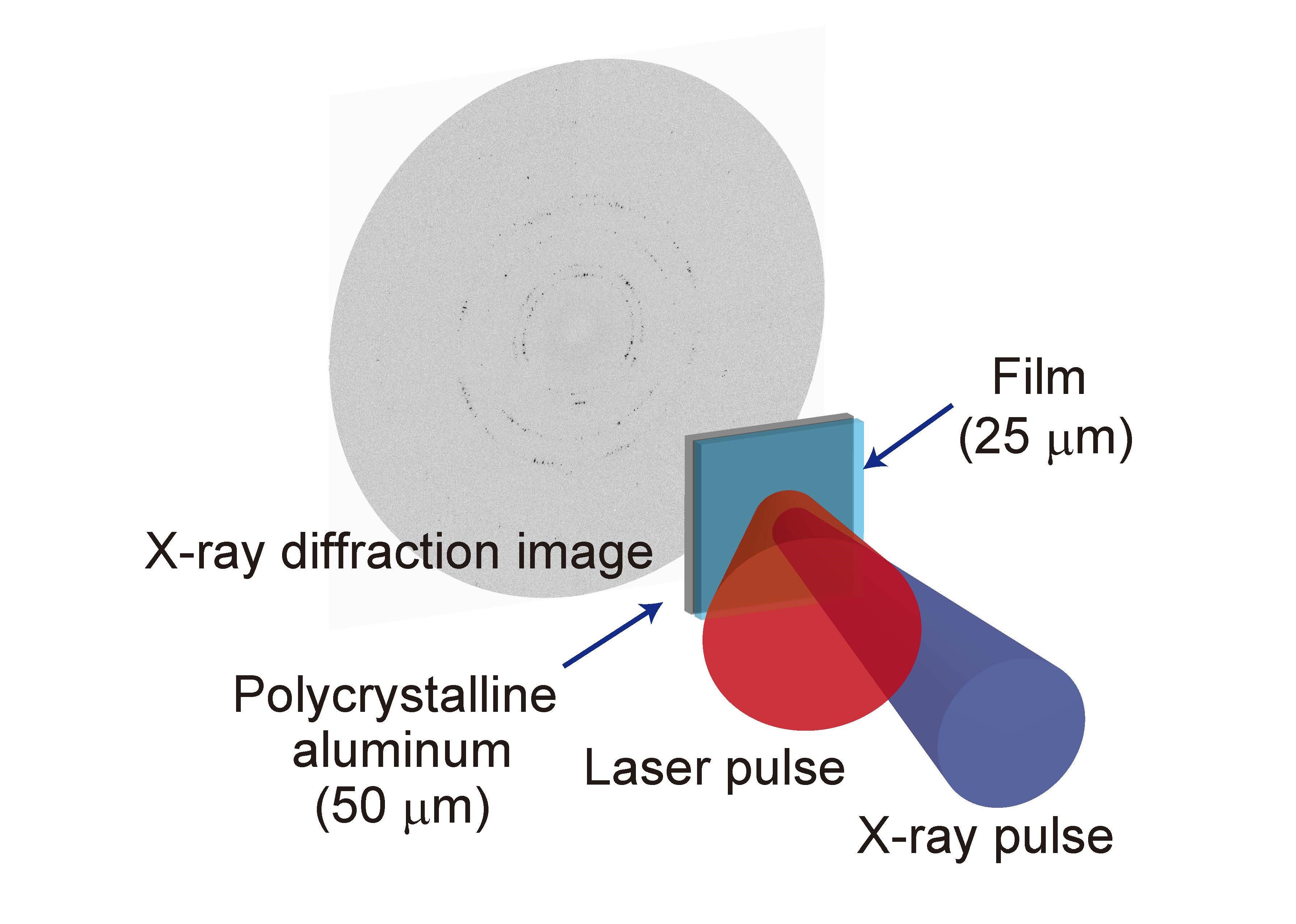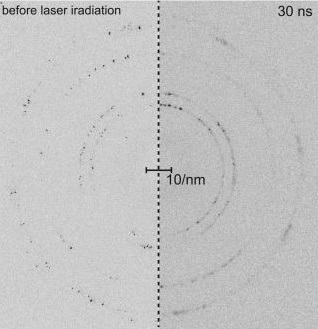Shaken and stirred: Scientists capture the deformation effect of shock waves on a material
Source:High Energy Accelerator Research Organization (KEK)
Jichi Medical University
Kumamoto University
Tokyo Institute of Technology
University of Tsukuba
Understanding how shock waves affect structures is crucial for advancements in material science research, including safety protocols and novel surface modifications. Using X-ray diffraction probes, scientists at the Institute of Materials Structure Science of KEK (High Energy Accelerator Research Organization), Tokyo Institute of Technology, Kumamoto University, and University of Tsukuba studied the deformation of polycrystalline aluminum foil when subjected to a laser-driven shock wave.
The foundations of engineering lie in understanding and manipulating the structure of materials to harness their properties in creative ways. Interactions between materials take place via the exchange of forces so predicting a material’s ability to withstand a force and how it propagates is central to developing structures with enhanced strength.
If an instantaneous strong force acting on a material results in a shock wave, the atoms may become displaced or dislocated. Like a rubber band, if the external force is not too significant, the internal forces can resist and the material can return to its original state (elastic deformation). But beyond a certain limit, the force may result in permanent damage or even structural failure (plastic deformation) of the material.
Unit cells are the smallest regularly repeating three dimensional atomic structure that reflects the overall symmetry of a crystal, and studying their displacement can provide rich insights. However, observing processes at the atomic scale is very difficult. This is where x-ray diffraction comes to the rescue. Envision a camera that allows you to capture events taking place at the atomic scale. When an x-ray encounters an atom it gets absorbed and then re-emitted by the atom. This results in the wave being scattered or diffracted in an orderly fashion, owing to the orderly arrangement of atoms in the crystal. Depending on the size, spatial arrangement, and distance between the atoms, the wave is scattered in different directions with different intensity. Thus, the atomic structure is captured as signals, like a photograph of the crystal during and after the shock wave passes. This can be used to decode crystal deformation.
Motivated by this, researchers conducted an experiment to observe the deformation process of polycrystalline aluminum foil when subjected to a laser-driven shock wave. This disturbance was then captured as diffraction spots of an x-ray beam which could be simultaneously compared to the diffraction pattern of the pre-shock crystal (Fig. 1). They found that large grains of aluminum were rotated, compressed elastically, and reduced in size along the wave direction. As the wave propagated deeper into the sample, the diffraction spots smoothed and broadened, and the original diffraction spots began to disappear, replaced by a new set of spots (Fig. 2). “We observed grain refinement and structural changes of the polycrystalline metal, which increased with the propagation of the laser-driven shock wave. This, in turn, enabled the study of microstructural deformation in plastic shock flows from the atomic to the mesoscale level,” stated Dr. Kohei Ichiyanagi of High Energy Accelerator Research Organization and Jichi Medical University.
Contemporary research of post-shock structural changes of materials often fails to highlight the process of wave dissipation and the distribution of defects. This research changes the status quo by providing a method to observe grain refinement and structural changes, including surface hardness and modification, of polycrystalline metal during shock wave loading. Optimistic about the potential of this research, Professor Kazutaka G. Nakamura of the Tokyo Institute of Technology said, “Our technique will be valuable for revealing mechanisms of microstructural change for various alloys and ceramics based on dynamic processes.”
Surely, this goes to show the creative ways we can expand the reaches of what we are able to see: this time, it’s how x-rays can be used to capture how particles are shaken and stirred!
Reference
| Authors: | Kouhei Ichiyanagi1,2, Sota Takagi2,3, Nobuaki Kawai4, Ryo Fukaya2, Shunsuke Nozawa2, Kazutaka G. Nakamura5, Klaus-Dieter Liss6,7, Masao Kimura2 & Shin-ichi Adachi2 |
| Title of original paper: | Microstructural deformation process of shock-compressed polycrystalline aluminum |
| Journal: | Scientific Reports |
| DOI: | https://doi.org/10.1038/s41598-019-43876-2 |
| Affiliations: | 1Division of Biophysics, Department of Physiology, Jichi Medical University Japan. 2Photon Factory, Institute of Materials Structure Science, High Energy Accelerator Research Organization, Japan. 3Division of Earth Evolution Science, Graduate School of Life and Environmental Sciences, University of Tsukuba, Japan. 4Institute of Pulsed Power Science, Kumamoto University, Japan. 5Laboratory for Materials and Structures, Tokyo Institute of Technology, Japan. 6 Materials and Engineering Science Program, Guangdong Technion-Israel Institute of Technology, China. 7Technion-Israel Institute of Technology, Israel. |

Figure 1. Diffraction patterns of deformed crystals
Aluminum foil irradiated by a laser-driven shock wave is followed by an X-ray pulse to read the diffraction pattern of the crystal structure.

Figure 2. Pre and post shock wave diffraction pattern of crystals
Diffraction images of polycrystalline aluminum foil before laser irradiation (left image) and after shock wave propagation (right image). The laser-induced shock wave pattern is smoothed due to plastic deformation.
Contacts
Hajime Hikino
Head, Public Relations Office
High Energy Accelerator Research Organization (KEK)
press@mail.kek.jp
+81-29-879-6047
Takashi Ogawa
Research Support Section
Jichi Medical University
shien@jichi.ac.jp
+81-285-58-7550
Jason Sanderson & Naoko Fukuda
University Research Administration (URA) Office
Kumamoto University
research-coordinator@jimu.kumamoto-u.ac.jp
+81-90-342-3307
Emiko Kawaguchi
Public Relations Section,
Tokyo Institute of Technology
media@jim.titech.ac.jp
+81-3-5734-2975
Naoko Yamashina
Office of Public Relations
University of Tsukuba
kohositu@un.tsukuba.ac.jp
+81-29-853-2039
About High Energy Accelerator Research Organization (KEK)
KEK was established to promote various types of researches as a center of excellence for overall development of Japan’s accelerator science (particle and nuclear research using high energy accelerators, research on the structure/function of matter including living organisms, research on improving the accelerator performance, and related basic technologies). As the Inter-University Research Institute Corporation, KEK provides researchers across the country and abroad with opportunities for research. With the Tsukuba and Tokai campuses as centers for excellence, KEK joins international collaboration experiments and developments. In addition, KEK, as a basic research organization under Graduate University for Advanced Studies, fosters scientists who will contribute to the promotion of accelerator science and advanced research fields.
https://www.kek.jp/en/
About Kumamoto University
Kumamoto University (KU), in its current form, was established on the 31st of May 1949, but its origins can be traced as far back as the mid-18th century. Now it is a globally active research university with strong roots in the local community. With seven faculties and eleven graduate schools, KU aims to cultivate creative people and provide them with the tools to thrive in the information age. KU’s research institutions and organizations strive to protect humankind’s cultural heritage, produce cutting-edge academic research, and promote sustainable development to help create a better future for the generations to come.
https://ewww.kumamoto-u.ac.jp/en/
About Tokyo Institute of Technology
Tokyo Tech stands at the forefront of research and higher education as the leading university for science and technology in Japan. Tokyo Tech researchers excel in fields ranging from materials science to biology, computer science, and physics. Founded in 1881, Tokyo Tech hosts over 10,000 undergraduate and graduate students per year, who develop into scientific leaders and some of the most sought-after engineers in industry. Embodying the Japanese philosophy of “monotsukuri,” meaning “technical ingenuity and innovation,” the Tokyo Tech community strives to contribute to society through high-impact research.
https://www.titech.ac.jp/english/
About University of Tsukuba
The University of Tsukuba aims to establish free exchange and close relationships in both basic and applied sciences with educational and research organizations and academic communities in Japan and overseas. While developing these relationships, we intend to pursue education and research to cultivate men and women with creative intelligence and rich human qualities.
http://www.tsukuba.ac.jp/en/

